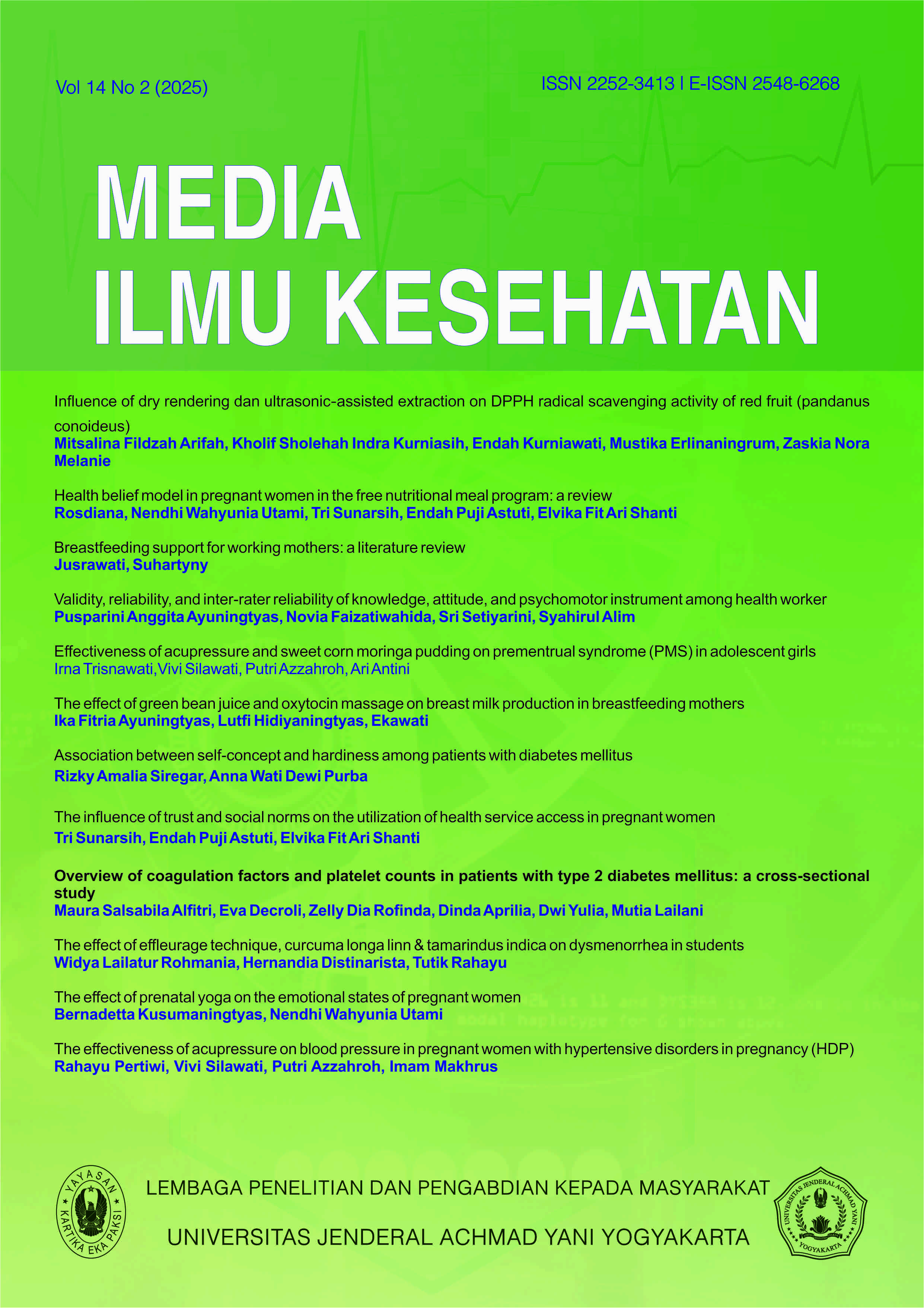Validity, reliability, and inter-rater reliability of cognitive, affective, and psychomotor instrument among health worker
DOI:
https://doi.org/10.30989/mik.v14i2.1684Keywords:
Affective, Cognitive, Health Cadres, Instrument, PsikomotorAbstract
Background: Health cadres have the potential to play a crucial role in community empowerment and disaster preparedness. Instruments are needed to support the development of comprehensive and efficient earthquake preparedness education programs for health cadres.
Objective: This study assess the accuracy and consistency of cognitive, affective, and psychomotor instruments in carrying out earthquake disaster preparedness in health cadres.
Methods: A cross-sectional study involving 90 respondents.
Results: The results of this study showed that all (n=90) participants were women with an average age of 31 years with an average education of senior high school. All participants were active health cadres. The instrument used in the study was validated through content validity (Pearson Product Moment) and biserial correlation, as well as Cohen's kappa. Utilizing internal consistency reliability, this study found satisfactory inter-item reliability for all cognitive (0.703-0.722) and affective (0.671-0.700) items, as well as all psychomotor items (0.464-1.000).
Conclusion: This instrument can be used to measure cognitive, affective, and psychomotor skills of health cadres.
References
1. UN Secretary-General. Report of the open-ended intergovernmental expert working group on indicators and terminology relating to disaster risk reduction. 2016;21184(December):1–41.
2. Atwii F, Sandvik KB, Kirch L, Paragi B, Radtke K, Schneider S, et al. WorldRiskReport 2022 - Focus: Digitalization - World | ReliefWeb. 2022. 75 p.
3. Rahayu D. Pengembangan Teknik Mitigasi dan Manajemen Bencana alam Gempa Bumi bagi Komunitas SMP di Kabupaten Bantul Yogyakarta. Departemen Koperasi Inspektorat Jenderal Republik indonesia; 2009.
4. Sinambela M. Mitigasi dan Manajemen Bencana. 1st ed. Medan: Yayasan Kita Menulis; 2021.
5. Kemenkes pedoman pelayanan kefarmasian. Ind p. kepmenkes RI. 2019. 70 p.
6. Badan Nasional Penanggulangan Bencana. Indeks Resiko Bencana Indonesia tahun 2022. 1st ed. Badan Nasional Penanggulangan Bencana Indonesia; 2023.
7. Rimadeni, Y. et al. Penguatan Kesiapsiagaan Kader Kesehatan Siaga Bencana Melalui Sosialisasi dan Simulasi Penanganan Kegawatdaruratan pada Kejadian Kebakaran di Kecamatan Meraxa Kota Banda Aceh. Jurnal Kreativitas Pengabdian Kepada Masyarakat (PKM). 2025;8: 1162–78.
8. Rustiawati E, Sulastri T, Dewi NH, Sultan U, Tirtayasa A. Kgd Hd. 2021;2(3):14–20.
9. Kamaluddin R. Pelatihan Dalam Peningkatan Kapasitas Kader Kesehatan Desa Di Daerah Rawan Bencana Gunung Berapi Kabupaten Banyumas. 2019;
10. Tamsuri A. Literatur Review Penggunaan Metode Kirkpatrick untuk Evaluasi Pelatihan di Indonesia. Jurnal Inovasi penelitian. 2022;2(8):2723–34.
11. BNPB. Indeks Resiko Bencana Indonesia (IRBI). Yunus R, editor. Vol. 02. Jakarta: Badan Nasional Penanggulangan Bencana; 2024.
12. Goldstein IL, Ford JK. Training in organizations: Needs assessment, development, and evaluation, 4th ed. Training in organizations: Needs assessment, development, and evaluation, 4th ed. Belmont, CA, US: Wadsworth/Thomson Learning; 2002. xxii, 410–xxii, 410.
13. BPBD DIY. Data dan Informasi Bencana Indonesia Daerah Istimewa Yogyakarta. [Internet]. Badan Penanggulangan Bencana Daerah (BPBD) DIY. 2021 [cited 2024 Oct 16]. Available from: https://bpbd.jogjaprov.go.id/assets/uploads/DIBI_2021_BPBD_DIY.pdf
14. UU No. 24 Tahun 2007. UU Nomor 24 Tahun 2007 Tentang Penanggulangan Bencana. Pravoslavie.ru. 2007;
15. Tondong HI, Hanaswati, Tempali SR. Peningkatan Pengetahuan Kader Kesehatan dalam Pendampingan Ibu Hamil pada Situasi Bencana Alam. Asmat Jurnal Pengabmas. 2023;3(1):57–67.
16. Mirzaei S, Eftekhari A, Sadeghian M reza, Kazemi S, Nadjarzadeh A. The Effect of Disaster Management Training Program on Knowledge, Attitude, and Practice of Hospital Staffs in Natural Disasters. Journal of Disaster and Emergency Research. 2019;(May).
17. Codreanu TA, Celenza A, Alabdulkarim AAR. Factors Associated with Discussion of Disasters by Final Year High School Students: An International Cross-sectional Survey. Prehospital and disaster medicine. 2015 Aug;30(4):365–73.
18. Solikhah MM, Krisdianto MA, Kusumawardani LH. Pengaruh Pelatihan Kader Tanggap Bencana Terhadap Kesiapsiagaan Bencana. Jurnal Ilmiah Ilmu Keperawatan Indonesia. 2020;10(04):156–62.
19. Sarmiento JP, Sarmiento C, Ramsey DW, Bevens D. Assessing Human Resources Development in Volcano Observatories Using the Knowledge, Attitude, and Practice Survey. Natural Hazards Review. 2022;23(4):1–9.
20. King D, Gurtner Y, Firdaus A, Harwood S, Cottrell A. Land use planning for disaster risk reduction and climate change adaptation: Operationalizing policy and legislation at local levels. International Journal of Disaster Resilience in the Built Environment. 2016;7(2):158–72.
Downloads
Published
How to Cite
Issue
Section
License
Copyright (c) 2025 MEDIA ILMU KESEHATAN

This work is licensed under a Creative Commons Attribution-ShareAlike 4.0 International License.
Articles received and published by the Media Ilmu Kesehatan are by the publication, the copyright of the article is fully transferred to the Media Ilmu Kesehatan. All operational forms such as printing, publication, and distribution of hard file journals are carried out by the Media Ilmu Kesehatan. Articles that have finished the review process and have been declared accepted by the journal manager or editor will be asked to fill out a statement of submission of copyright by the journal secretary to the main author or correspondent author. The statement of transfer of copyright is signed with a seal and sent via email to journalmik2018@gmail.com and contacted the admin of the journal to be followed up on archiving. Journal managers and editors have the right to edit the manuscript according to the provisions of the writing rules in the Media Ilmu Kesehatan.
Articles that have been declared accepted either online through the author's account on the OJS website https://ejournal.unjaya.ac.id/index.php/mik or a letter of receipt of the article (LOA), as well as those that have been published on OJS are not allowed to be published in other journals, or proceedings. The number of authors with more than one and as the main author or designated as the correspondent writer must have coordinated with members of the research team. The order of the authors submitted in the article as the author of one, two, three and so on cannot be changed when the article is published unless an error occurs in the technical operation of the journal.












